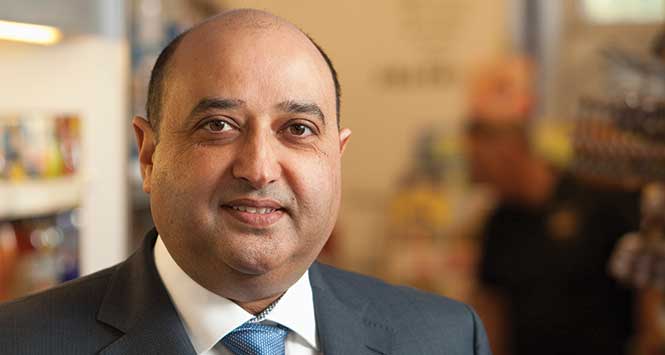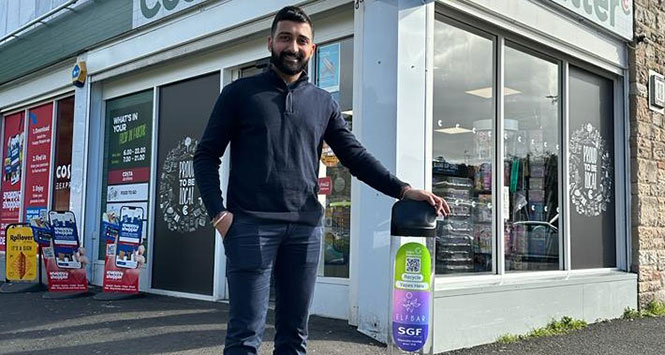It’s time once more for SLR’s annual vox pop from all four corners of the industry to find out what they think will be the important opportunities and challenges that lie ahead of us for 2020.
David Lonsdale
Director, Scottish Retail Consortium
Forecasting is tricky at the best of times. What can be said with certainty however is that the prospects for retailers in 2020 will ultimately be determined by the state of the economy and by their own ability to adapt and seize on the opportunities that arise.
The former will be greatly influenced by the outcome of the UK General Election, the impending UK and Scottish Budgets and how the politicians fund their promises, and the next steps with Brexit. If the next UK Government can command some sort of a Parliamentary working majority, and if the fog of Brexit lifts and reasonable certainty prevails, then there ought to be some renewed optimism on consumer spending. Employment levels remain high and real wage and population growth bode well and hold out the prospect of a better year ahead, after what has been a pretty tepid period for Scottish retail sales growth.
Profound changes in shopping habits and the technology revolution are testing the business model of every retailer, and this won’t slow up. Indeed any uptick in spending on more discretionary items is likely to exacerbate that further, at least temporarily, given the high online penetration that already exists in such categories. Retailers who are fleet of foot and with a strong multi-channel offer and capability should be well placed to succeed.
What is certain too is that retailers will continue to face a more interventionist and less permissive approach from policy makers. That will apply across areas from employment policy to issues such as the environment and health. It will challenge retailers’ ability to keep costs down for households at a time when margins will remain thin. However, there will be opportunities too, whether on better legal protections for shop workers, finally securing a level playing field with England on business rates, or the creation of a retail strategy for Scotland.
Despite the economic and political headwinds there are grounds for cautious optimism – retailers’ ingenuity, resilience and determination is seeing them reinvent themselves for the future. The retail revolution will continue apace and no matter what is thrown its way the industry will adapt and overcome and play its role in driving forward Scotland’s economy.
Pete Cheema
Chief Executive, Scottish Grocers’ Federation
2020 is set to be another challenging year for retailers with so much uncertainty ahead around the effects of the forthcoming General Election and of course Brexit, which is unlikely to be resolved in any meaningful way in the short term unless one party secures a big majority.
Next year is also a big year for new legislation for SGF and the industry, not least thanks to the huge amount of preparation work that will be required next year to get the Deposit Return Scheme set up in time for the 2021 implementation date. SGF sits on the Implementation Group and will continue to do all we can to represent the interests of our Members. Unquestionably a large part of next year will be taken up with lobbying the Scottish Government on this issue.
Another significant lobbying challenge will be around the HFSS (High Fat, Sugar & Salt) legislation which is set to have a massive impact on the local retailing trade. It will fundamentally change how retailers can merchandise many products in their stores and where they can site them. The Scottish Government now seems to be telling us how to run our own businesses and SGF will be fighting them every step of the way on behalf of our Members.
We’re also facing new energy drinks legislation – despite the fact that many convenience stores have followed a voluntary code prohibiting sales to under 16s for years – and the wider sustainability issue will also have a much bigger impact on how we operate our businesses in 2020.
Legislation surrounding the vaping and CBD categories is another major issue for next year with a proposed tightening of the marketing and advertising of these products potentially set to force vapers back to cigarettes, even though it’s widely accepted by important objective bodies like Public Health England that vaping is 95% less harmful than combustible tobacco. This debate will potentially be intensified by the ban of menthol tobacco products in May next year.
As for CBD, it’s one area where our industry would potentially welcome more legislation in order to strip out some of the less legitimate CBD businesses that are muddying the waters in what could be a very important category for our sector.
The cumulative cost and burden of the never-ending legislation is having a massive impact on our business. It is time that different departments within government did some joined up thinking and an analysis to work out the impact of continued legislation on convenience retail.
One thing is for sure: 2020 won’t be dull!

Colin Smith
Chief Executive, Scottish Wholesale Association
As SWA enters its celebratory 80th year, 2020 will be our year to celebrate. A time to celebrate a calendar of events designed in conjunction with our supplier members to showcase how wholesalers can harness the opportunity that the sustainability and environmental challenge offers them and their customers.
We will celebrate enhancing our people and their digital skills with the first phase of our new Training Academy, initially focusing on younger workers and skilling new recruits entering our industry. This will develop throughout 2020 to include supervisors and middle managers.
We will celebrate the high profile of SWA, our sector and our members that we’ve strengthened within Holyrood during 2019. This has enabled us to make our voices louder than ever as we work with the Scottish Government on the next round of HFSS (High Fat, Sugar & Salt) consultations, the Circular Economy Bill, the National Living Wage, Local Enterprise Zones and any new election pledges that impact Scottish wholesalers, suppliers and customers.
As retail and foodservice markets continue to merge, let’s celebrate our collaborative efforts with industry partners. Projects such as the National Food Tourism Strategy and work with the seafood industry have ensured that SWA is helping create new opportunities that will enable our members to ride the economic challenges ahead.
It’s clear however that 2020 will start off the same unpredictable way that 2019 will end with Brexit and DRS high on that agenda. Let’s celebrate that January and March we will hopefully have some financial clarity on what both will look like and we can start shaping our businesses for the future.
Let’s celebrate too that in 2020, whatever the challenges, whatever the opportunities, SWA will continue supporting our members with guidance, lobbying and ultimately a strength in membership.
A strong, skilled, knowledgeable and opportunistic wholesale sector means a strong, skilled, knowledgeable and opportunistic retail sector.

Blake Gladman
Strategy & Insight Director, KAM Media
In a short space of time the value of the ‘low & no’ category has grown rapidly and I see it being a major category in 2020. In the off trade in the past year, £43m was spent on low/no-alcohol beers, for example, and we’re also seeing a rapid growth in demand for low and non-alcoholic versions of spirits and wines. The low & no category is being driven by growing trends of ‘tee-totalism’ and consumers looking to reduce their alcohol consumption for health reasons. KAM Media research showed that 2 in 5 18-24-year-olds describe themselves as teetotal; more than twice the number of UK adults in general. Knowledge of this relatively unknown category is currently limited across the convenience retail channel. However, I believe it hits a potential sweet spot for the channel.
We already know that awareness and demand for health and well-being products is now a mainstream trend across UK consumers, but couple this with the heritage for small format retailers being the ‘go-to’ channel for alcohol and soft drinks and you can start to see the opportunity that this could provide. Distress purchases, entertaining and meal for tonight are just some of the key shopper missions which are the heartland of the convenience store and the low & no category fits snuggly into these shopping trips whilst helping to future-protect them for retailers in 2020 and beyond. In summary, the growing demand for a decent low & no range is not going away and it should be an area which the convenience channel sees as an opportunity to be ahead of the curve and create a real point of difference.
Jim Eccleston
Managing Partner, 56 Degrees Insight
Our research identifies four specific challenges likely to face the Scottish convenience store sector in 2020:
- Health & Wellbeing: The search for the healthier option will be a continuing trend in 2020. Scots are increasingly likely to pay attention to ingredients – not just calorific content but artificial flavourings, sugar and unsaturated fat. When it comes to alcohol, the recent Minimum Unit Pricing legislation is delivering a reduction in volume of take-home alcohol bought overall, and drinkers paying more for what they do imbibe. In 2020, the non-alcoholic and low alcohol sector will continue to grow at a faster rate than elsewhere in Britain, as a growing proportion of the population looks to moderate their drinking habits.
- Sustainability and environmental issues: As consumers become ever more aware of the environmental impact of their choices, packaging is increasingly recyclable. C-stores have an opportunity given the growing consumer desire for plastic-free fruit and vegetable aisles and a move to paper bags instead of plastic.
- Provenance: knowing where your food and drink comes from and how it is produced is increasingly important to Scots consumers. Telling the story of the product on packaging and display materials will become increasingly common next year as brands seek to develop an interest and intrigue. This approach can highlight the provenance of the product in an engaging way which can appeal to the consumer – with display opportunities to be had for the convenience store.
- ‘Scottishness’ and importance of locality: National identity has always been important to Scots and manifests itself in food and drink branding too. We recently undertook research which explored how Scots felt when faced with a direct choice of two identical food items – one with a UK flag and labelled ‘100% British product’ and the other with a Scottish flag and labelled ‘100% Scottish product’. The value of Scottish branding was clear: 56% would choose the product branded ‘Scottish’ whereas only 4% would choose the ‘British’ labelling. This has implications about how products are displayed and promoted in store to maximise their appeal.

John Patterson
Sales Director, JUUL Labs UK
Grasping the vaping opportunity will be key for Scotland’s local retailers in the year to come. Despite 26% year on year category growth, independent and symbol retailers are still playing catch-up. Vape sales in independent retailers grew 28.8% over the past year – beating their symbol counterparts who achieved growth of 22.8% – but still lagged behind the multiple channel which posted 37% growth and a total category growth of 31.8% in traditional retail according to IRI.
Together independents and symbols have a combined 28.2% of the traditional retail sector. Multiple retailers continue to have the majority of vaping sales with a market share of 62%. Over the same period, closed pod systems have increased their share of the total market from 12.5% to 31.6% while liquids – although still in growth – have seen their overall share decline from 47.7% to 39.6%.
Despite solid growth this year, the independent and convenience channels are still underperforming. This signposts the huge potential for growth still to come within the category and for the channel.
Although independents were slower to see the potential of closed pod vaping systems, they are now catching up. This time last year, closed systems accounted for just over 6% of all vaping sales in c-stores. That figure is now over 28%. Although open systems still dominate the sector and should be a major part of any vape offer, the gap is narrowing rapidly as closed pods become the system of choice for adult smokers looking to switch. One of the main reasons the multiples are pulling ahead is that they embraced closed pod systems earlier and closed systems now outperform open system sales in their stores.
Closed pod systems are driving 80% of the total market growth in traditional retail and although independents have 28% of this sector, if we include specialist vape and online stores, their combined vape share is around 12%. The opportunity lies in these stores getting the same share of vape as they have in tobacco – roughly 45%. Adult smokers looking to switch expect to see smoking alternatives in the stores where they buy tobacco. By providing a credible vaping solution with simple, convenient closed pod systems at its heart, independents can retain these customers instead of pushing them into other channels. The good news is that there is still fantastic headroom for growth as 60% of the UK’s seven million adult smokers want to quit and see vaping as the preferred method to begin their switching journey.

Amy Burgess
Senior Trade Communications Manager, Coca-Cola European Partners
The soft drinks category has performed incredibly well in 2019. It is now worth £8.5bn [Nielsen, Sep 2019] and continues to grow suggesting that it will be a hugely important category for retailers again in 2020. As part of our Total Beverage Company Vision we are committed to evolving our portfolio to reach more consumers, on more occasions, in turn providing convenience stores with more opportunities to increase their sales.
In 2020 we expect to see the demand for low and no sugar products increase across different sectors, including colas. Diet Coke remains the most popular light cola brand in GB , with a value of more than £464m, while Coca-Cola zero sugar is growing significantly, currently up 28.9% in value in GB, which we expect to continue into 2020.
We will also continue our ongoing efforts to offer more low-calorie options to our consumers across different categories and occasions. With 40% of convenience store shoppers rating a range of healthy products as important [HIM CTP, 2018], it is vital for us to introduce even more low and no sugar variants across different formats for consumers to enjoy.
Shoppers are becoming more adventurous and are looking to experiment with new and exciting variants of their favourite soft drinks. More than a third of shoppers (35%) [HIM CTP, 2018] agree that they like trying new things when grocery shopping, so retailers should keep an eye out for the latest soft drink flavour innovations launching in 2020.
The success of our 2019 NPD, including Fanta Zero Grape, which is now is now worth nearly £5m according to Nielsen, and the latest additions to our Light Colas portfolio, Diet Coke Twisted Strawberry and Coca-Cola zero sugar Raspberry, shows that consumer demand for flavour innovation in our low-sugar soft drinks portfolio remains high.
We will also continue to explore ways we can reach new consumers by expanding our brands into different segments and occasions. This year has seen us launch our Monster Brand into the RTD coffee section with Espresso Monster, which is now worth £3m, and Coca-Cola enter the energy segment for the first time in its history with Coca-Cola Energy, the number three soft drink launch of 2019 to date. We will look at new emerging trends in 2020 to see how we can diversify our brands to meet the latest consumer demands.”

Leigh Sparks
Professor for Retail Studies, University of Stirling
Locally based consumer-focused retailing is still very much in demand. Yet, the challenges are considerable and will continue to grow in 2020. The specificity of local convenience stores can be challenged by new stores, and operators such as Aldi are experimenting with convenience-sized local operations. Competition has not gone away, it has changed.
Secondly, the cost base is a challenge. Convenience stores may gain from rates relief, but as a physical operator, employing significant numbers of people, costs and taxes which are more easily applied to these characteristics continue to grow. Is it too much to hope from Westminster and Holyrood that these policies be thought through from the viewpoint of valuing employers who require space and put people at the heart of communities rather than from that of an automated, distant fulfilment centre?
Thirdly, convenience stores are in the firing line for the changing expectations of consumers and governments. Some of this is positive in that local and personal has become a positive in retail. But, especially in Scotland, what we expect from convenience retailers has changed. From tobacco control and promotional restrictions on alcohol to possible restrictions on ‘unhealthy’ foods and with minimum unit pricing and deposit return schemes also to contend with, the nature of retail operations is altering. The focus on healthy living and sustainability is not a bad thing for 2020 but it does require adaptation and change, and this can be tough to get right, especially in smaller operations.
Only time will tell if my 2020 vision was perfect or clouded. Convenience stores, especially those embedded in the local community have a great future, but it is hard won, and that is not about to change in 2020.

Tom Fender
Development Director, The Whole Sale Company (TWC)
The annual ‘new trends next year’ articles typically focus on new foods we’re allegedly going to be eating (but often don’t), the latest names of consumer groups to target, or revolutionary technologies which will improve our lives. All of these are valid. The world changes and we must all change with it. But there is one area which I don’t believe has had much attention in the convenience sector to date… but it’s a potential game-changer… and that area is: data.
When the directors of Dunnhumby presented the results of their three-month pilot of gathered shopper data to the Board of Tesco in 1994, a deathly silence apparently fell across the Boardroom… until Lord Ian Maclaurin (Chairman) declared in a rather annoyed and terse tone: “You know more about my shoppers in 12 weeks than I know about them after over a decade of running this business.”
Now, I don’t mean to be controversial at this festive time of the year but when I hear businesses big and small say they “know their customers”, I reflect on the fact that I have sat in at least 1,000 presentations or meetings about ‘the customer’ where knowledge on ‘the customer’ is actually quite sparse. I think we want to think we know the customer. But the reality is, most of us know some customers, some of the time. But often decisions are made without robust data to make a fully informed decision. As Sherlock Holmes said: “It is a capital mistake to theorise before one has data.”
Without data, businesses are blind and deaf and in the middle of a motorway. If the convenience sector is to stay ahead of the competition in 2020, we will need to start using the ‘goldmine’ of data we sit on. I don’t believe many businesses in the sector are doing this. How many Chief Data Officers exist in the UK convenience sector? Will this be the next big job function in our industry?
Wholesalers have an opportunity to become data-driven organisations to support their independent retailers. Retailers can use data to understand what’s working, and what’s not on their smartphones or laptops. Data can report performance by SKU, by store, by region, by time of day, and by day of the week. Sales figures can be merged with a host of other data sets to inform management and indicate how to improve performance. Organisations who use data well perform better than the organisations who don’t.
For me, it’s the companies who utilise and exploit their data as central to their digital engine room will be the big winners in 2020 and beyond… because data is the new oil.

James Bielby
Chief Executive, Federation of Wholesale Distributors
FWD has identified six priorities for the new Government to address in 2020 which will protect the profitability of the wholesale sector and the 450,000 retail and catering businesses it supplies and supports. These include pushing for a comprehensive, frictionless trade deal after Brexit which keeps tariffs or trade barriers to a minimum, showing restraint on National Living Wage increases, and introducing further measures to tackle alcohol duty fraud and sugar tax evasion.
With packaging producer responsibility rules likely to be under review in a new parliament, FWD asks the new Government to maintain the current exemption for distributors, without which its members would see cost increases of up to 300%. It also believes that mandatory allergens database is necessary to guarantee consumers access to full and accurate information on the potentially harmful ingredients in the food they purchase.
Following a decline in police response to incidents at members’ premises, which has led to tobacco and alcohol products being stolen from customers and distributed illegally, FWD calls on the Home Office to commit greater resources to prevent crime and prosecute criminals who target wholesalers and their customers.
We are asking for a fair playing field for this vital industry which supports public services, small businesses and remote communities. For wholesalers to thrive, legislation that affects them must be effective, it must be achievable, and it must be proportionate.
We are therefore asking the Government to join us in ensuring that future policy enables the sector to grow, thrive and importantly support our workforces, customers and communities.”
Ed Sibley
Commercial Director, HIM
The convenience channel is undeniably growing (up 3.5% YoY in 2019), but at the same time the grocery landscape continues to evolve rapidly, especially with traditional footfall drivers. This serves to highlight the importance of retailers being adaptable to changing consumer needs to stay in business.
Technology is transforming the sector, albeit in pockets rather than unilaterally. Innovations like self-service checkouts are gradually becoming more mainstream but won’t suit all stores. The arrival of the online delivery specialists like Deliveroo presents a fantastic opportunity for the sector, which should be embraced.
Food-to-go is the elephant in the room. It is undoubtedly a key driver of footfall across the wider market, but despite significant investment in range, refrigeration and marketing, the convenience channel is not growing overall share due to stiff competition from specialist foodservice operators. However, coffee-to-go is a booming trade. It is also a great gateway into food-to-go for retailers who don’t want to commit fully to the breakfast and lunchtime meal occasions.
Looking forward, declining levels of alcohol consumption are giving deserved limelight to the innovative ‘low 2 no’ category. This is an area where c-stores must lead and become first choice for consumers looking for an alternative to traditional soft drink or BWS products. There are many other manifestations of the mega-trend of health – ranging from the increasing interest in CBD (and its apparent health benefits) to the potentially huge vaping market in the future.
The convenience market has never been a one size fits all model, but it is more important than ever to embrace the cliché of understanding your customer of 2020, which is likely to be very different to the shopper of five years ago.

Truls Haug
UK Managing Director, TOMRA
Plans for a deposit return scheme (DRS) for Scotland have gathered significant pace over the last year and we can expect even more momentum as we move into 2020.
The results of the DRS consultation showed there is undoubtedly an appetite for an ambitious, “world class” scheme.
Cabinet Secretary Roseanna Cunningham answered a myriad of questions on the practicalities of scheme – which could be implemented as soon as spring 2021 – when she addressed the Environment, Climate Change and Land Reform Committee recently.
She acknowledged the scheme would mean significant change but reminded the committee that many other countries have successfully delivered it and overcome the challenges.
TOMRA can certainly testify to that – we operate in markets across the globe and have seen an array of different models being brought in.
When we speak to retailers their questions are mostly around space, cost and the materials that will be included. The good news is that there are a range of solutions out there for all store sizes, enabling retailers to be ready for the implementation of the final DRS design. The year ahead will bring more answers on the specifics of the scheme and we are excited to see the final regulations when they are published. There is no doubt that sustainability and recycling will continue to be a hot topic for consumers in 2020. Scottish retailers will want to be talking about the significant contribution to sustainability they already make and how an ambitious DRS will push that claim even further.

Adbul Majid
Retailer, Nisa Local Bellshill
As another challenging year draws to a close there have been occasions when fleetingly, the thoughts of retirement have crossed my mind. The prospect of more time with Mrs Majid and all the jobs need doing around the house made me realise maybe things in retail aren’t as bad as I think!
However, things are looking up as my son Umar joined the business this year and was the inspiration in driving our fresh food offer and the recently completed store refit. So, for the first time in a while, I look forward to a brighter future in 2020.
The challenges enveloping our industry remain and increase with every passing year. Whereas those of my age may reflect on a long-gone golden era of retail but what of those now at start of their careers? They may look back at this time as their golden era. Perspective is everything.
I am now being constantly challenged on my way of doing things, challenged on what we stock and even where it is sited within the store. Have I been too loyal to brands no longer deserving the same commitments of the past? Food is the future. Our future lies in delivering fresh, high quality, great value food. Maybe a little bit of old school retailing will survive but hey, I’m no longer handcuffed to the past.
This son of mine’s energy is infectious, and I very much look forward to a new era in our store. We’ll be concentrating on the things we can control and not worrying about those we can’t!

Mohammed Sarwar
Blairgowrie Post Office
There are around 1,400 convenience stores in Scotland with a Post Office and that number will only rise in 2020 as more and more retailers switch on to the benefits of providing a service that puts their shop at the heart of the community.
Customers can already access the widest range of life’s essentials at the Post Office – Royal Mail and Parcelforce services for posting locally or abroad and sending or collecting parcels; banking on behalf of the UK’s high street bank accounts for business and personal customers; holiday money, passport renewals, travel insurance and International Driving Permit applications, plus Post Office make it easy to pay all sorts of bills including utilities, phone, and council tax. That list gets bigger on New Year’s Day, when a new contract with British Gas means its customers will be able to undertake all over-the-counter bill payment services at Post Offices.
All of those reasons are probably why, according to HIM research, 93% of shoppers are more likely to use a store because it has a Post Office, and 68% began using a store when it added one. Kantar research shows that shoppers spent an average of £8.16 on shopping while on a Post Office mission.
For retailers interested in driving their business forward in 2020, the Post Office provides everything you need to get up and running; it’ll train you and your staff, and a business support manager will be on hand for your first six months. After that it provides support online, by phone and during area manager visits.
On top of that, the fees postmasters get for providing PO services in their branches in 2020/21 will be 10% higher than in 2018/19.
A Post Office is suitable for all types of convenience store, CTNs and forecourts. Premises need to have easy access and enough space for the counter. All business opportunities are on the Run a Post Office website. It also recruits retailers to run branches in new locations where there isn’t currently a Post Office. It has some non-compete supplier relationships, and you’ll need to integrate the Post Office into your retail business.
There is no franchise fee involved. The Post Office supplies and fits all equipment and signage, and delivers stock and cash. There’s also no fixed term contract to worry about, although retailers are expected to be fully committed to the benefits they’ll bring to their local community when taking on a Post Office.









